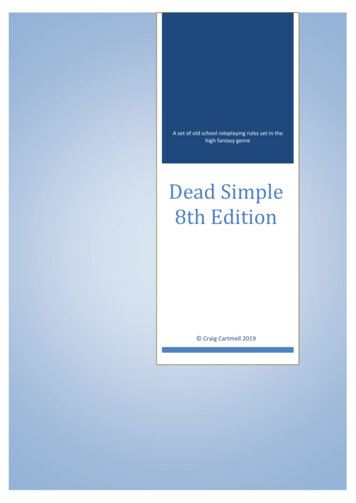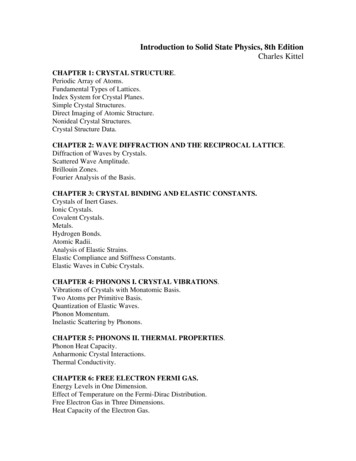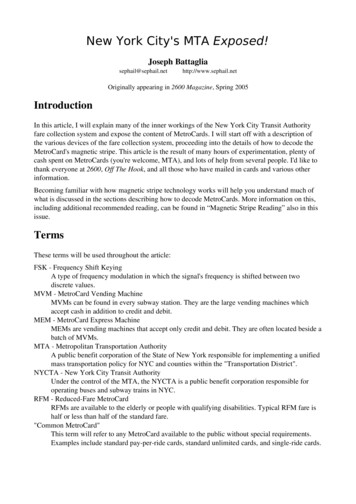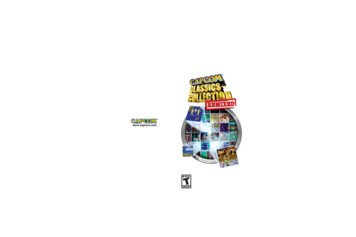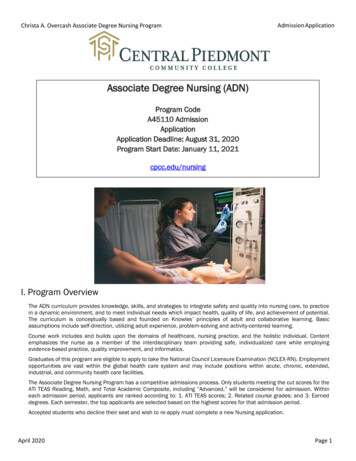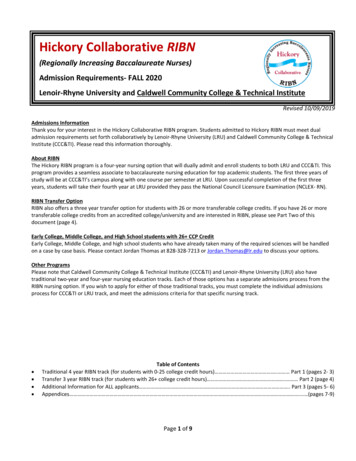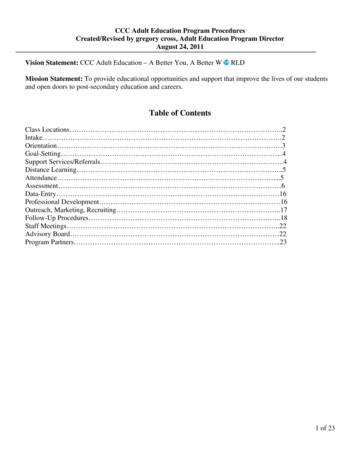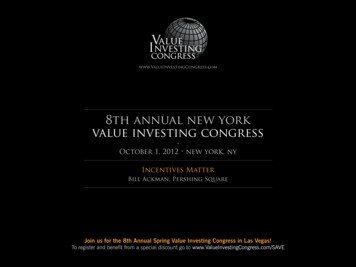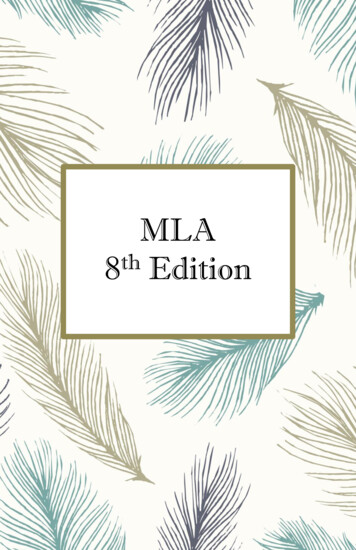
Transcription
MLA8th Edition
MLA 8 EditionthCitation StylesWhat is MLA? MLA stands for Modern Language Associationa way to document sources used within the paperWhat does MLA affect? formatting of the paperin-text citations within the paperWorks Cited page at the end of the paperWhy should sources be documented?Sources should be documented to give credit to others’ work give the reader a way ofverifying the information withinthe paper add strength (validity) to theinformation within the paper avoid plagiarismHow to use this bookletThis booklet contains information onmany different aspects of the MLA 8thedition. See the table of contentson the next page for the particularsections that you need to use tohelp you with your paper.The word plagiarismcomes from the Latinword plagiariusmeaning kidnapper.Plagiarism is when awriter uses someoneelse’s language,ideas, or otheroriginal (notcommon knowledge)material withoutacknowledging itssource.All information was taken from the MLA Handbook EighthEdition. This resource is available at the campus bookstore. Youmay also come to the Writing Center or visit us online atwww.cccti.edu/WritingCenter for assistance.1
Citation StylesTable of ContentsMLA Formatting . 5MLA format requirements . 5Front Page formatting . 5In-Text Citation formatting . 5Works Cited page formatting . 5The Basics . 7In-Text Citation Basics . 7Quotation Basics . 7Quotation Examples . 8With author’s name in introductory phrase . 8Without author’s name in introductory phrase . 8Author with more than one work cited . 8Quote from a poem . 8Block Quotation . 8Citing Secondary Sources . 9Citing Works with no Author Credited . 9The Core Elements of an MLA Citation . 101) Author. . 11One author . 11Two authors . 11Three or more authors . 11No Author?. 1228.1.19
Citation StylesEditor, Translator, . 12Performer, etc. . 12Organization . 12Username . 122) Title of source. . 13Titles in Italics . 13Titles in “Quotation Marks”. 133) Title of container, . 144) Other contributors, . 145) Version,. 156) Number, . 157) Publisher, . 158) Publication date, . 169) Location. . 16Creating a Works Cited Entry . 17Citation Examples . 18Printed Sources . 18Book with one author . 18Book with two authors . 18Book with three or more authors . 19Anthology . 19Book with editor as author . 20Selection within book with editor as author. 20Bible or Other Religious .2138.1.19
Citation StylesWork . 21E-book . 21Brochure . 22Handouts . 22Online Sources . 23Website with author . 23Website without author . 23Corporation as author . 24Dictionary . 24NCLive article . 25NCLive article with DOI . 25YouTube video. 26Movie/DVD . 26Image. 27Blank Formatting Boxes . 2848.1.19
MLA FormattingCitation StylesMLA format requirements 12-point, Times New Roman fontdouble spacing1-inch margins on all sideslast name and page number in the upper right cornerTo format page numbers:In Microsoft Office 2016, select insert, then page number, top ofpage and select the third option: plain number 3.Type your name before the page number so that it appears onevery page. Change the size and type of font to 12 point, TimesNew Roman to match the rest of your paper.Front Page formatting In the top left corner, put your name, instructor’s name, thecourse number, and the dateDates in MLA areTitles are centered on the next line;written in thistitles are not in bold, underlined, ororder: day,italicizedmonth, and year.In-Text Citation formatting In-text citations are located within the work. There is aperiod after the in-text citation. See the individual examplesthat show how each in-text citation looksWorks Cited page formatting The Works Cited page should begin on a new page following thepaper.Make sure to add the hanging indent to all entries.Alphabetize sources by the firstitem such as author’s last name orIf your entry beginsthe title if no author’s name iswith the word the,given.use the next wordto alphabetize.58.1.19
Citation StylesDent 1Stew DentMr. SmithENG 112-10224 May 2016Looking Through the GlassPoet, author, and playwright: these are all accurate descriptions ofTennessee Williams, yet somehow, those words fail to express the broad impactof his works on American culture. Born in 1911, Thomas Lanier Williams wasthe second child of Cornelius and Edwina Williams. At age five, Thomasbecame very ill with diphtheria and nearly died. During his lengthy recoveryyoung Thomas became more introverted, discovered the joys of reading, writing,and using his very fertile imagination (Heintzelman and Smith-Howard 4).Williams began writing stories at a very young age, and his first short story,“Isolated,” was published in his junior high school newspaper (Roudane svi). Helater adopted his college nickname, dropped the name Thomas, and becameTennessee Williams. Williams’ “first critical acclaim came in 1944 when TheGlass Managerie opened in Chicago and went to Broadway. It won a ‘PulitzerPrize, the New York Drama Critics Circle Award and, as a film, the New YorkFilm Critics’ Circle Award’” (“American Masters”). Like many authors,Williams often used his personal experiences as the foundation for his stories.Significant people and places in a writer’s life may be vaguely alluded to orblatantly caricatured in his or her works. Tennessee Williams uses his earlyfamily life for the basic structure of many of his works including his firstsuccessful play The Glass Managerie, vividly sketching a portrait of theinterpersonal relationships and underlying tensions in his family.68.1.19
The BasicsCitation StylesIn-Text Citation Basics In-text citations are usedthroughout a paper whenParaphrasing is whendirectly quoting,you take the meaningparaphrasing, orfrom another’s ideassummarizing a source.and express it in yourIn-text citations are theown words.same no matter which wayyou choose to incorporate source material.MLA citations consist of author and page number.For poetry, use the author and the line numbers.If the source is electronic, no page number is required.Quotation Basics Quotations from lessQuotations are any timethan four lines of prose orthat another’s words arethree lines of poetryused. These words shouldare considered shortbe set apart inquotations.quotation marks.Quotations of more thanfour lines of prose or more than three lines of poetry mustbe set apart from the rest of the text in a block quotation.The quote should begin with an introductory phrase.Quotation marks should surround the quote and then befollowed by the parenthetical (in-text) citation and thenthe sentence punctuation.When using the author’s name in the sentence, omit thename from the in-text citation.If there is more than one work from the same author, thenthe in-text citation requires the author’s name, title of work,and page number.When quoting poems, separate the lines with spacebackslash space ( / ).78.1.19
Citation StylesQuotation ExamplesWith author’s name in introductory phraseIn The Glass Menagerie, Williams pens Amanda as a Southern belle, andshe recalls, “Among my callers were some of the most prominent youngplanters of the Mississippi delta” (981).Without author’s name in introductory phraseIn The Glass Menagerie, the mother, Amanda, is a true Southern belle,and she recalls, “Among my callers were some of the most prominentyoung planters of the Mississippi delta” (Williams 981).Author with more than one work citedTom says that Laura is “terribly shy and lives in a world of her own andthose things make her seem a little peculiar” (Williams, The GlassMenagerie 999).Quote from a poem“’Twas brillig, and the slithy toves / Did gyre and gimble in the wabe;” (Carroll lines 12).Block QuotationThese must be set apart from the rest of the text by indenting theentire quote one inch from the left margin and omitting thequotation marks. The introductory phrase will be followed by acolon.Tom sails from port to port in the Merchant Marines searching for someway to ease his guilt. In his essay “Entering the Glass Menagerie,” C.W.E.Bigsby comments:[Tom Wingfield] revisits the past because he knows that his ownfreedom, such as it is, has been purchased at the price ofabandoning others, as Williams had abandoned his mother and,more poignantly, his sister. He “writes” the play, moresignificantly, perhaps, because he has not affected that escapefrom the past which had been his primary motive for leaving. (37)Tom’s memories of his life with his mother and sister are all the morepainful because they are the incarnation of Williams’ real-life experiences.88.1.19
Citation StylesCiting Secondary SourcesIn some cases, the information that you use from one source maybe quoted material from another source. In this case, both theoriginator of the quote and the source that you are looking at mustget credit in the text.For example, you are reading Smith’s article, and in the article,Smith quotes Jones’ work. If you want to use Jones’ ideas, youneed to give credit for both the ideas (Jones) and where you foundthe information (Smith’s article). On the Works Cited page, citeSmith’s article because it is the source you found and read. Thereare two in-text citation options: With Jones’ name in the introductory phrase:In his book Conversations with Tennessee Wiliams, Robert Jones quotesWilliams as saying, “the glass animals came to represent the fragiledelicate ties that must be broken, that you inevitably break, when you tryto fulfill yourself” (qtd. in Smith 37). Without Jones’ name in the introductory phrase:One author recalls Williams as saying, “the glass animals came torepresent the fragile delicate ties that must be broken, that you inevitablybreak, when you try to fulfill yourself” (Jones as qtd. in Smith 37).Citing Works with no Author CreditedWhen no author is associatedwith the work to be cited, thefirst thing that appears on theWorks Cited page, i.e., the titleof the work, is used in place ofthe author’s name.A long title can be shortened inthe citation, but the first wordsof the title must be used tosignal the correct source onthe Works Cited page.The three storms that raged across the mid-west in January and Februaryof 1978 are “collectively known as the Blizzard of 1978” (“1978 Ohio”).98.1.19
Citation StylesThe Core Elements of an MLA CitationThere are nine core elements to any works cited entry. They arelisted in the chart below in the order in which they should appear.Nine Core Elements.1) AuthorElements will be omittedfrom the works citedentry if it is notapplicable to the workyou are citing.2) Title of source,4) Other contributors,5) Version,6) Number,7) Publisher,8) Publication date,9) Location. elements are found for the source that you areOnceall of the3) Title of containerusing, then you can put them together to form a citation.Author. Title of Source. Title of container, Other contributors,version, number, publisher, publication date, location.108.1.19
Citation Styles1) Author.The author is the person or persons responsible for writing thework. The citation will look a little different depending on thenumber of authors.One authorBegin with the author’s last namefollowed by a comma and thenwrite the rest of the author’s name.This is followed by a period.Two authorsInclude the authors in the orderthey are presented within thework. Reverse the name of thefirst author as you do with oneauthor. Then, follow it with acomma and the word and thengive the second author’s name innormal order.Three or more authorsOne author:Smith, John R.Two authors:Stanley, Claire, andRobert Jones.Three or more authors:Holland, Marie, et al.In-text citations for the aboveexamples will look like:Write the first author’s lastname followed by a commaand then write the rest of theauthor’s name. Then, write acomma after the first nameand the words et al.(Smith)(Stanley and Jones)(Holland et al.)118.1.19
Citation StylesNo Author?For some works, there may not be a person’s name listed.However, you may have the name of an editor, translator,organization, etc. For these types of sources follow the examplesbelow.Editor, Translator,Performer, etc.Write the last name followed by acomma and then the first namefollowed by a comma and theirconnection to the text.If there is more than one name,follow the rules of more than oneauthor.common connections:One person:Wingfield, Tom, editor.Two people:Rickman, Alan, andEmma Watson,performers.Three or more:Mur, Cindy, etal., translators.editor, translator, username,creator, performerOrganization:United Nations.Username:@grammargirl.OrganizationAuthors do not have to beindividual persons. Works maybe created by a corporation,institution, association,government agency, or any other kind of organization.UsernameOnline usernames are mostly given like regular author names.128.1.19
Citation Styles2) Title of source.The title of the source is a required component of creating theMLA citation.The formatting of the title is important so that your reader willknow instantly what type of source you are talking about. If asource is self-contained, then it is written in italics. If a source ispart of a larger work, then it will be formatted with “quotationmarks” surrounding it.The Great GatsbyTitles in ItalicsAmazonItalics are used for big things.The New York TimesThese are things that stand alonePride and Prejudiceby themselves as a unit. Thenames of books, websites,journals, movies, and televisionseries are written in italics.Many times, these types of sourcesare listed as the container. If it isthe only source, then it can belisted here.Titles in “Quotation Marks”Quotation marks are for smallerthings that are often within thelarger works; therefore, thenames of chapters, web pages,articles, or particular episodes ofa television show are all inquotation marks.13“A Rose for Emily”“The Writing Center”“Group Prenatal Care:An Analysis of Cost”“Me, Garfield, and I”Titles are given in the entry in fullexactly as they are found in thesource. The only exception is tocapitalize and punctuatestandardly.8.1.19
Citation Styles3) Title of container,When a source that is being documented is part of a larger source,then the larger source is considered the container that holds thatsource. The title of these containers is normally italicized.Typical containers are bookwebsitejournalmagazinenewspapertelevision seriesanthologiesBe careful when distinguishingbetween a web page and awebsite.For example, on the school’swebsite, Caldwell CommunityCollege and Technical Institute isthe name of the website and “TheWriting Center” is the name of aparticular page on the website.4) Other contributors,This is a second type of author spot. So, if you have alreadyincluded the editor as the author, then do not include it here. Listthese names in normal order, i.e. Firstname Lastname.Common descriptions of other contributors are adapted bydirected byedited byillustrated by 14introduction bynarrated byperformance bytranslated by8.1.19
Citation Styles5) Version,If the source indicates that it is from a version other than theoriginal, then write this information here.Common words to indicate version are edition, version or cut.6) Number,Some sources may be part of a numbered sequence. If so, indicatethe volume and number, or, in the case of television, season andepisode, here.Make sure to use the abbreviations for volume and numberwhen writing out this information. For example, a source involume 64 number 1 would look like: vol. 64 no. 17) Publisher,The publisher of a work is the organization or person primarilyresponsible for paying for the work and making sure that it wasproduced.In this section,
Citation Styles 5 8.1.19 Dates in MLA are written in this order: day, month, and year. MLA Formatti
